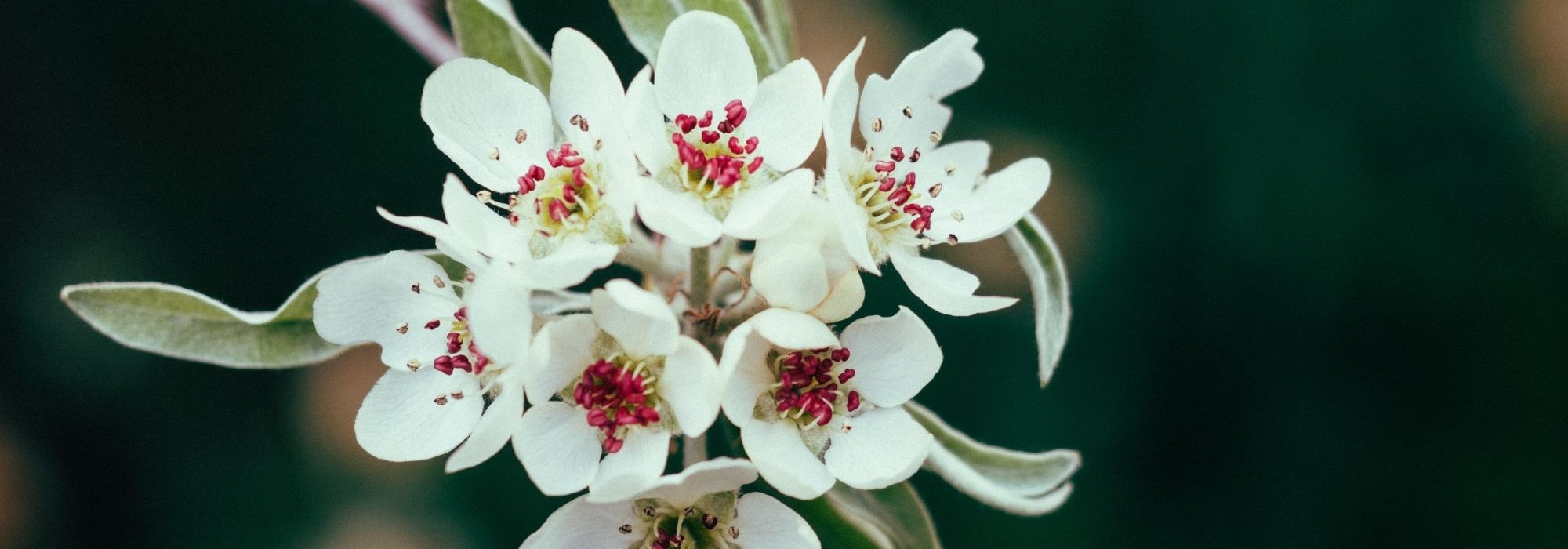
Flowering pear tree, ornamental pear tree: planting, growing, care
Contents
The flowering pear in a nutshell
- Flowering pears offer an abundant white flowering in spring, as well as a deciduous foliage that ignites in autumn.
- Frost and drought resistant, and not very susceptible to diseases, their maintenance is also limited and they do not require pruning.
- Easy to grow and with a fairly rapid growth, they adapt to almost all soils and can also be grown in pots.
- Large shrubs for full sun or light partial shade, their elegant silhouette and low footprint allow them to be integrated into many types of gardens.
The expert's word
Flowering Pear trees, also known as ornamental Pears, Japanese Pears, or Chinese Pears, are cousins of Pyrus communis, the common Pear, which is available in various varieties cultivated for the flavour of their fruits. Ornamental Pears, such as Pyrus calleryana ‘Chanticleer’, are primarily valued for their generous white spring flowering, often fragrant, as well as for their light foliage, which displays stunning warm hues before falling late in autumn. Other species feature silvery foliage and a graceful habit, capable of rivaling an olive tree, with added hardiness! Pyrus salicifolia is a perfect example.
Flowering Pear Trees are indeed frost-resistant down to at least -20°C, and they tolerate all types of soil, as long as it is not too calcareous. Compact and relatively fast-growing, they are also less prone to diseases than fruiting species and require simpler maintenance. Their elegant habit, more or less pyramidal or fastigiate, the light shade they provide, and their ease of cultivation (even in pots) make them essential small trees for gardens of all sizes or terraces, even for less experienced gardeners.
Description and botany
“`html
[plant_sheet latin_name=”Latin name: Pyrus” family=”Family: Rosaceae” common_names=”Common names: flowering pear, ornamental pear, Chinese pear, Japanese pear” flowering=”Flowering: spring” height=”Dimensions: 5 to 15 m X 3 to 9 m” exposure=”Exposure: sun, light partial shade” soil=”Soil: any type, not too calcareous” hardiness=”Hardiness: very good (-20°C on average)” bgcolor=”#ccaa84″ alignment=”left” /]
Pears, botanically known as Pyrus, include fruiting species (Pyrus communis, Pyrus pyrifolia or ‘Nashi’…), well-known for their juicy flesh, as well as varieties with high decorative value, commonly referred to as ornamental pears, flowering pears, Chinese pears, or even Japanese pears (Pyrus calleryana and its various cultivars, Pyrus salicifolia, Pyrus betulifolia…).
These large bushes or small trees belong, like apple trees or roses, to the family of Rosaceae. They grow spontaneously in temperate Eurasia (China, Taiwan…) and North Africa.
Just like flowering apple trees, flowering pears also produce fruits, which are much smaller than their orchard cousins, and while they are edible, their hardness and astringency give them low culinary value. These small pears, averaging 1 to 3 cm in diameter, can be bronze, russet, cinnamon, golden, or green, and they provide a valuable food source for the garden’s small wildlife.
If ornamental pears are so popular, it is due to their abundant white or slightly pink-tinged spring flowering, their grey-green foliage that often persists late into the season, and the autumn hues that the leaves take on at the end of the season. The displayed colours embrace a wide range, from golden yellow to scarlet red, passing through various shades of Bordeaux, gold, orange, or purple, sometimes blending on the same tree. Pyrus salicifolia ‘Pendula’‘ does not change colour, but its long silvery foliage and weeping habit make it a choice specimen in landscaping. Its Mediterranean look is indeed a very interesting alternative for gardeners whose harsh climate does not allow for olive cultivation.
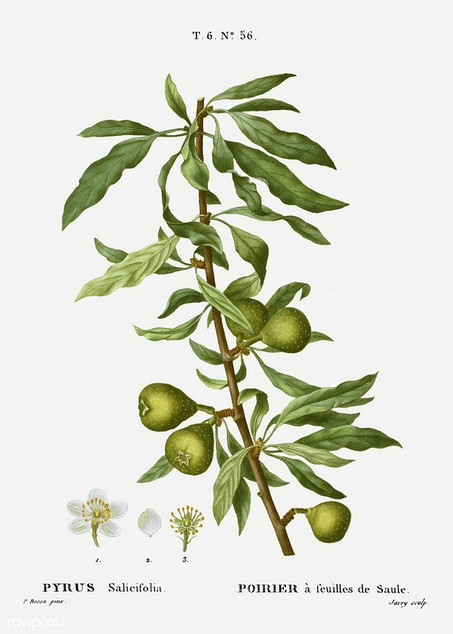
Pyrus salicifolia – botanical illustration
The vast majority of ornamental pears are deciduous, with the exception of species like Pyrus kawakamii. The foliage, grey-green, is borne on long petioles, and even the slightest breeze makes the branches rustle pleasantly, casting a light shade. The leaves, 4 to 8 cm long, are alternate, glossy, and oval in shape, more or less elongated, with slightly dentate edges (except in Pyrus salicifolia). The foliage of Pyrus betulifolia, as its name suggests, mimics that of a birch.
The branches are often thorny, but some varieties exhibit an inermous character, such as ‘Bradford’ or ‘Aristocrat’. The bark of the pear tree is dark brown and fissured.
Flowering pears, which have a fairly rapid growth rate (Pyrus pyraster, the wild pear, is somewhat slower), are generally not large trees. The largest can reach about 15m, but many species and varieties are of more modest size, and have a reduced ground footprint. Thus, varieties like Pyrus calleryana ‘Chanticleer’ or ‘Redspire’ rarely exceed 10 metres and offer a narrow, pyramidal to fastigiate habit, thus taking up little space. Pyrus ussuriensis (the Manchurian pear) reaches only 9m but has a larger spread (7m). Pyrus kawakamii has a rounded shape of 9 m in all directions, and it is a species that lends itself well to training. With an equivalent spread, Pyrus calleryana ‘Bradford’ is one of the tallest (15m). Among the smaller ornamental pears, we can mention Pyrus betulifolia (7m x 5m) or Pyrus salicifolia ‘Pendula’ (5m x 4m). Finally, the botanical species close to the common pear, Pyrus pyraster, reaches 15m in height and 8m in width.
These variable dimensions lead to quite diverse habits, some being much more columnar, others conical, pyramidal, or oval. In any case, there is a variety for all sizes and configurations of gardens.
The flowering of pears occurs in spring, usually before leafing out. The buds, dark pink, bloom in umbels of simple flowers with 5 sepals, fused at the base, and 5 petals, white or slightly pink-tinged, each flower measuring 3 to 5 cm in diameter. About twenty stamens adorn the heart of the flowers, whose styles (the slender parts extending from the ovaries) are fused, unlike what is observed in apple trees. Some varieties are pleasantly fragrant, while others are known to be less pleasant to the nose, with Pyrus calleryana ‘Bradford’ leading the way.
The fleshy fruits ripen in autumn. They are round in shape (similar to small apples) and more or less elongated. They are actually false fruits, which botanists call pyridions. The true fruit is essentially what is commonly referred to as the core, which contains the seeds (the pips), enclosed in 5 carpellary lobes.
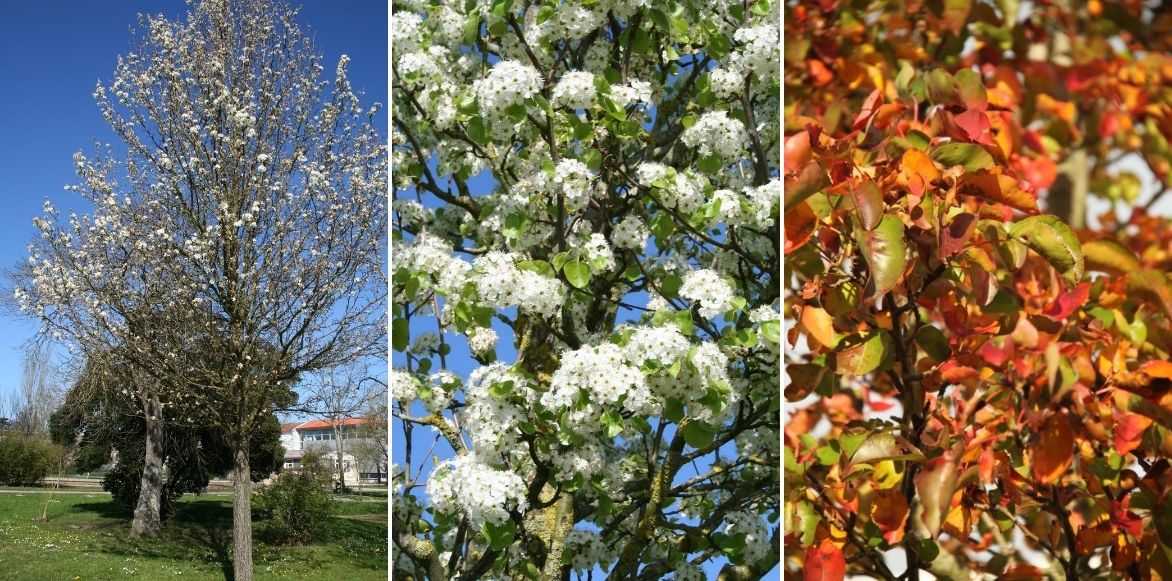
Pyrus calleryana ‘Chanticleer’: habit, flowers, and autumn foliage
Although the main interest of these trees lies in their flowering and autumn colours, the fruiting is also interesting for the food it provides to certain garden animals.
Pears being allogamous, they require cross-pollination for good fruit set. It is therefore advisable to check that another pear tree is present nearby (on your property, at a neighbour’s…), or to plant one, in order to promote fertilization. The presence of an ornamental pear nearby cultivated species for their fruits is also a guarantee of better pollination for the latter. To learn more, feel free to consult our article on the pollination of fruit trees.
It may happen that the tree self-seeds, and the seedlings obtained may produce specimens different from the parent tree, but interesting (or not!) for their ornamental qualities.
In some regions of the United States, with climatic conditions different from ours, Pyrus calleryana ‘Bradford’ has been classified as invasive, due to its propensity to self-seed uncontrollably. Residents are sometimes offered an alternative tree if they get rid of the one in their garden. However, this is a problem we do not face in our latitudes.
Chinese pears withstand -20°C without flinching and they resist drought well once established. Their deep rooting also provides good wind resistance. ‘Bradford’ again makes an exception to the rule, as its branches easily break under snow or gusts, making its lifespan shorter than other varieties.
Container cultivation (of good dimensions) is possible, and flowering pears can thus find a place on a terrace, for example. The space allocated to the roots being more restricted in a pot, the dimensions of the tree will therefore be reduced.
“`
Some popular varieties
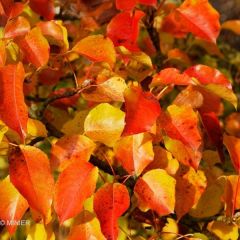
Pyrus calleryana Chanticleer - Callery Pear
- Flowering time April, May
- Height at maturity 10 m
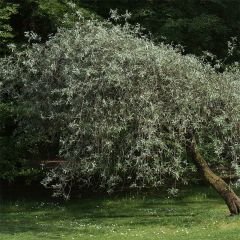
Pyrus salicifolia Pendula - Pendulous Willow-leaved Pear
- Flowering time June, July
- Height at maturity 5 m
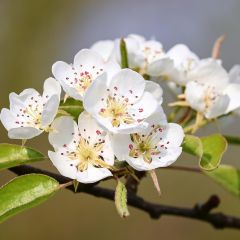
Pyrus pyraster
- Flowering time May, June
- Height at maturity 15 m
Discover other Pyrus - Ornemental Pear tree
View all →Available in 1 sizes
Available in 3 sizes
Available in 2 sizes
Flowering pear tree planting
Where to plant?
Ornamental Pear Trees are easy to grow and, due to their good hardiness, can be planted in almost any territory. They prefer open and sunny locations (possibly partial shade), but not scorching conditions. Because of their deep rooting, opt for a non-superficial, rather rich, cool but well-drained soil. A bit of lime does not deter them, but avoid very alkaline soils.
When to plant?
The best planting time is autumn, but pot-grown specimens can be planted all year round, except during frost periods, provided that water supply is sufficient in the initial months.
How to plant?
Planting an ornamental pear tree delivered in a container
- Soak the pot in a large volume of water until the substrate is saturated.
- In the meantime, dig a hole twice as wide and deep as the size of the pot.
- In poor soil, add a scoop of compost.
- In windy regions, plant a sturdy stake in the hole, facing the wind (i.e., to the west of the trunk if prevailing winds come from that direction). Unsure about the usefulness of a stake? On our blog, Olivier provides all the advice on staking trees.
- Remove the root ball from its container, lightly scratch the soil to ensure the roots are not damaged (if necessary, make small cuts with clean pruning shears) and that they are directed outward.
- Place some of your mix at the bottom of the hole, then position the root ball (against the stake if you have placed one), and backfill with the excavated soil.
- Firm the soil at the base and create a basin to channel water towards the roots. The surface of the soil should be level with the ground.
- Water generously (about 10 litres), even in rainy weather, to eliminate any air pockets around the roots.
- Mulch with at least 5 cm (dead leaves, bark, compost…).
- If you have placed a stake, tie the trunk to it using a soft tie.
Planting an ornamental pear tree delivered bare-root
- Dig a hole 2 to 3 times wider and deeper than the size of the root system of your specimen.
- Pour some of the excavated soil (possibly mixed with potting soil) into the bottom of the hole, forming a dome in the centre.
- Check that the roots of your specimen are not damaged. Trim slightly and cleanly if necessary.
- Prepare a slurry (a mix of well-decomposed horse manure or cow dung, soil, and water) or use a ready-to-use slurry. The consistency should be similar to mud.
- Dip the roots in the slurry so that they are coated with this mixture.
- Immediately plant your pear tree in the hole, on the dome you created (optionally inserting a stake against the roots, without damaging them), ensuring that the roots are spread outward.
- Keep the trunk upright while you fill in with the remaining soil.
- Firm lightly and create a basin to concentrate watering towards the roots.
- Water generously (10 litres), even if it rains, to ensure contact between soil and roots.
- Mulch with at least 5 cm thickness (dead leaves, commercial mulch…).
- Secure the trunk to the stake using an appropriate tie.
- Carefully check that the roots do not lack water in the weeks following planting.
Planting a flowering pear tree in a pot
- Choose a pot about 50 cm on each side, with drainage holes.
- Place a drainage layer at the bottom of the pot (clay balls, gravel…)
- Fill with rich, good-quality potting soil.
- Remove your pear tree from its pot and position it in the centre of the pot, ensuring that the top of the root ball is about 5 cm from the top of the pot.
- Top up with potting soil, without burying the root ball further, firm down, and then water generously.
- Mulch with bark, flax straw, or any other material of your choice.
Pruning, maintenance and care
Flowering pear trees are easy to grow and less sensitive than their fruit-bearing cousins.
Pruning
It is not essential to prune ornamental pear trees. If necessary, you can intervene at the end of winter (February-March) to remove dead wood and rebalance the branches, while avoiding the removal of the largest branches to maintain the natural habit of the bush.
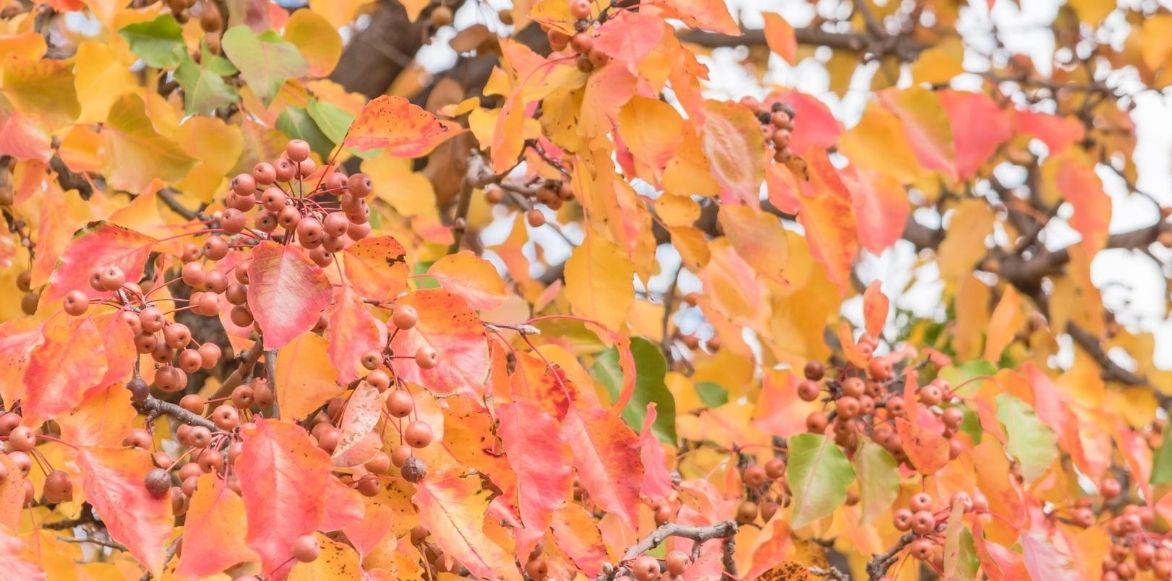 Pyrus calleryana in autumn
Pyrus calleryana in autumn
Diseases and pests
More resistant than fruit-bearing varieties, Chinese pear trees can, however, sometimes be affected by a few issues, especially under poor growing conditions (lack of aeration, poor planting, insufficient biodiversity, inappropriate exposure…).
- Tiny whiteflies can establish colonies on the leaves, leading to the formation of sooty mould (a type of sticky black soot). Treat with a spray based on black soap.
- Aphids and caterpillars may also be present on the plant. In this case, a biological treatment using Neem oil can help limit attacks.
- Much rarer but also more problematic, bacterial fire, caused by a bacterium (Erwinia amylovora), can kill a tree in one season. It is also a highly contagious pathogen. Leaves dry out and blacken, young shoots curl, and the flowers themselves can be affected until the disease spreads to the roots and kills the affected tree. This bacterium is most likely to act during flowering, especially if the weather is mild and humid. There is no curative treatment. In case of symptoms, cut several centimetres below the affected parts and burn them. If bacterial fire spreads, the only solution is to uproot and burn the diseased tree. A prophylactic treatment (horsetail manure) can help your bush strengthen its natural defences. A copper spray (in small quantities) is also possible just before flowering. If you prune your flowering pear, remember to use clean and disinfected pruning shears, and to clean them again when moving from one tree to another. Once again, be aware that flowering pear trees are much less sensitive to bacterial fire than some of their fruit-bearing cousins.
- Finally, cankers may appear following pruning under certain climatic conditions and on aging trees. To learn all about this disease, identify the symptoms, and treat accordingly, consult our article on tree and fruit tree cankers.
Multiplying the flowering pear tree
It is possible to propagate flowering pear trees by sowing, but propagation by cuttings is preferred.
Propagation by sowing
Ornamental pear trees self-seed naturally, and sowing can also be carried out by the gardener, but due to spontaneous pollination, the resulting plants are rarely identical to the parent plant. However, you can have fun collecting the young plants and replanting them elsewhere (in autumn). You may then have some pleasant surprises… or not!
Propagation by cuttings
- In early spring, summer, or early autumn, take a healthy, vigorous branch piece about twenty centimetres long, cutting above a node or branch junction.
- Trim your cutting just below a node (to remove the lower branch piece) and dip the base in plant hormone.
- Fill a pot with a light, well-draining mix (for example, 50% potting soil, 50% coarse sand), and make a pre-hole using a piece of wood.
- Insert your cutting into the potting mix, firm it down, and then water.
- Cover with a plastic bag and place the cutting in a bright location but out of direct sunlight.
- When new shoots appear, remove the plastic bag and monitor the watering.
- When the root system is well developed, repot into a larger pot or plant your pear tree directly in the ground.
Pairing ideas
The ornemantal pear tree is cultivated for its stunning spring flowering and its sumptuous autumn colours. Its habit, resistance to wind and diseases make it an excellent choice for planting in rows in urban areas or to frame a grand driveway. It is equally suitable for use as a specimen, in hedges, or for creating a colourful landscape display that supports biodiversity. Finally, it is an excellent ally in orchards, where it promotes the pollination of fruiting species.
- In a country-style flowering hedge, beautiful in all seasons, pair your Flowering Pear with Serviceberries (with beautiful spring flowering and sumptuous autumn colours), Viburnums (some of which are particularly fragrant), Judas Trees, Photinias (evergreen foliage should generally represent about 1/3 of the species included in a hedge), Ornamental Apples, or even Cotinus. To thicken this hedge, you can add, in a staggered pattern, Forsythias, Japanese Quince, Barberries, or even Decorative Dogwoods (whose brightly coloured branches enliven winter).

An example of a hedge association: Viburnum, Serviceberry, Judas Tree, and Willow-leaved Pear
- In a border, for example, pair your Pyrus with small bushes (Forsythia, Fothergilla, Euonymus, Hydrangea, Choisya…) some of which offer both fresh flowering and autumn hues that blend beautifully with those of the pear. In the lower tier, plant generous-flowering perennials (Aubrieta, Omphalodes, Iberis, Japanese Anemones, Asters…) and decorative foliage (Epimedium, Heucheras, Muckdenia…). Essential, spring-flowering bulbs (Daffodils, Tulips, Crocuses…) should not overshadow the fact that others also bloom in autumn, such as Colchicums, which accompany the warm hues of the pear’s foliage in late season.
- Pyrus salicifolia pendula, with its silver foliage and weeping habit, can visually replace an olive tree in regions where the climate is too harsh for the latter. This species is already stunning as a focal point in a specimen, but you can also use it, in well-drained soil, alongside Euphorbias, Artemisias, Nepeta, or Dianthus. A few early-flowering bulbs will add touches of colour to the composition at the start of the season.
- Grey is also a colour that softens and links together bolder hues while highlighting them particularly well. An association that works very well with roses, especially if you incorporate ornamental grasses, whose upright habit allows for an interesting play on shapes and volumes.
Did you know?
- Pyrus calleryana derives its species name from a French missionary, Joseph-Marie Callery, who introduced it to Europe from China in the mid-19th century.
- It is the only tree that survived the collapse of the Twin Towers in Manhattan during the attacks on 11 September 2001. Discovered amidst the rubble, almost entirely decapitated and burned, it quickly sprouted new green shoots. It was decided to transplant it to a nursery where it received careful attention. It finally returned to “Ground Zero” in 2010, and this “Survivor Tree” now stands once again on the site, as a symbol of remembrance, resilience, and rebirth. This speaks volumes about its strength and durability!
Useful resources
- Subscribe!
- Contents
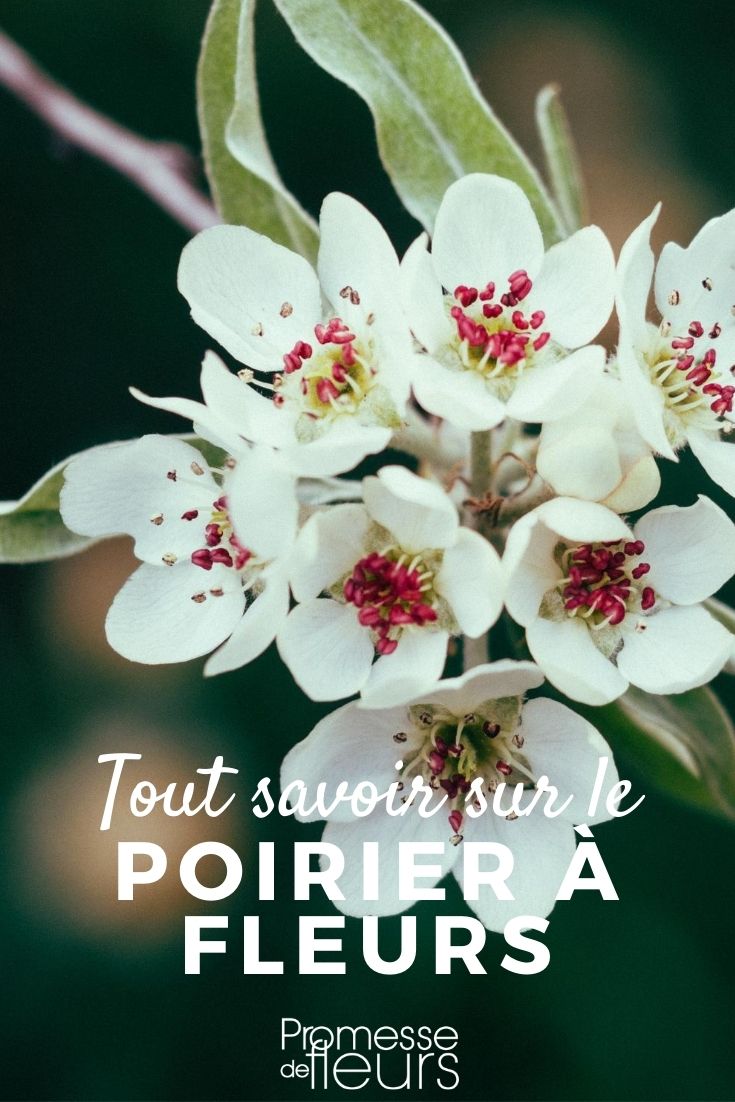


































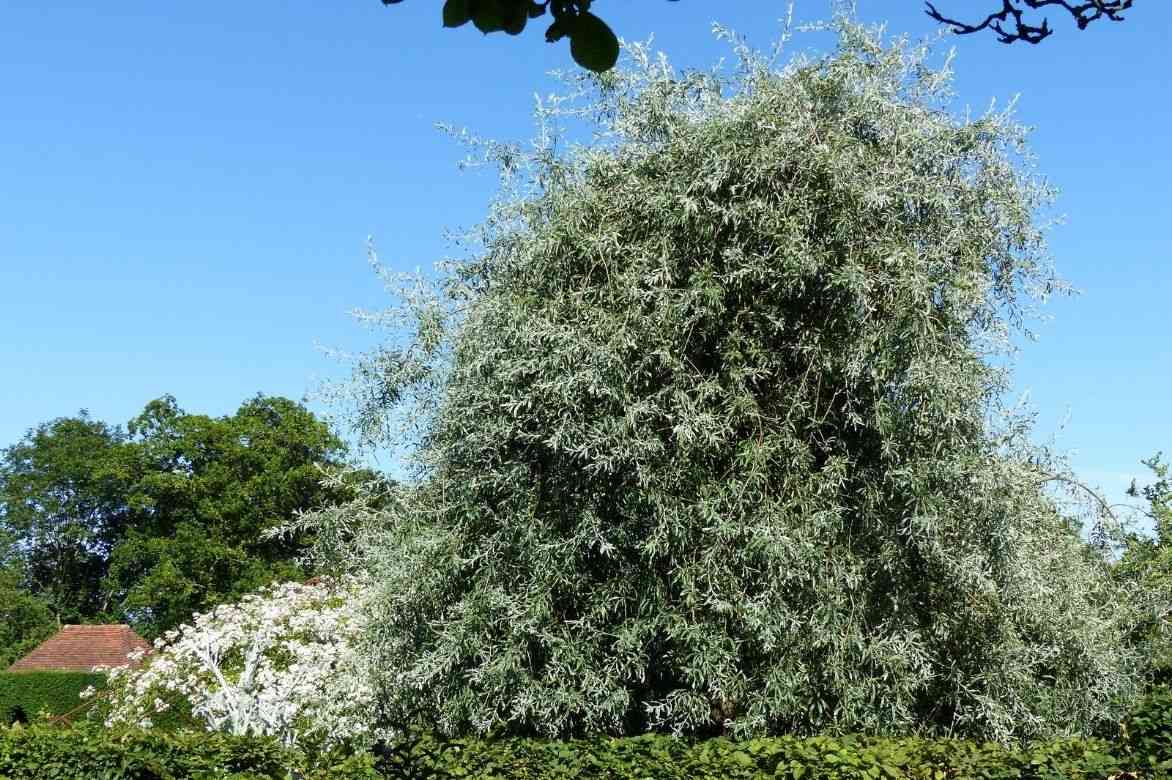
Comments